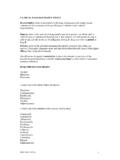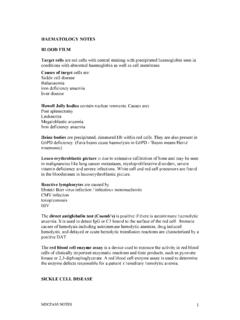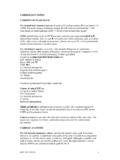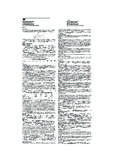Transcription of ACUTE TUBULAR NECROSIS - MRCPass.com
1 RENAL NOTES. ACUTE TUBULAR NECROSIS . A rapid rise in creatinine following periods of hypotension is most commonly due to ACUTE TUBULAR NECROSIS . In ATN, urinalysis usually shows granular casts. Urine sodium is typically high due to TUBULAR sodium loss, concentration is typically above 30 mmol/l. The urine to plasma osmolality ratio <1:1, the ability to concentrate urine is preserved despite sodium loss. ACUTE TUBULAR NECROSIS is associated with accelerated hypertension, hypotension, diabetes, liver failure, eclampsia, aminoglycosides, Cephalosporins, Cisplatin, Amphotericin and Ciclosporin. Haemodialysis is useful for salicylates and NSAIDs, lithium, and in particular, Antifreeze poisioning. It is not useful for tricyclics, amiodarone and paraquat, paracetamol and digoxin, which is mostly tissue bound (use digoxin binding antibodies). Indications for urgent dialysis are: uraemia pericarditis with effusion pulmonary oedema significant hyperkalaemia (>7) with evidence of ECG changes rapidly rising urea and creatinine In haemodialysis patients, sodium intake has to be moderated - high intake may cause fluid overload.
2 Aluminium levels may accumulate in dialysis patients, so antacids containing aluminium should be avoided. PTH levels are usually high. Continuous Ambulatory Peritoneal Dialysis (CAPD): Recent inguinal hernia surgery and history of perforated diverticular disease are relative contraindications. Large volumes of intraperitoneal fluid may compromise severe COPD. Patients with severe arthritis will not be able to manage peritoneal bag changes. NEPHRITIC AND NEPHROTIC SYNDROME. Infectious causes of ACUTE nephritic syndrome are: staphylococcus pneumococcus v chickenpox malaria Non infectious causes ACUTE nephritic syndrome: Membranoproliferative glomerulonephritis IgA nephropathy Henoch-Sch nlein purpura systemic lupus erythematosus mixed cryoglobulinemia Goodpasture's syndrome Wegener's granulomatosis MRCPASS NOTES 1. Proteinuria Microalbuminuria is protein >30 mg/l but dipstick testing can detect protein >300mg/l. 2+ proteinuria approximates to 1g/l of prtein.
3 3+ proteinuria approximates to >3g/l. The diagnosis of nephrotic syndrome comprises the triad of oedema, proteinuria >3g/d and hypoalbuminaemia. Hypercholesterolaemia is present in nearly all patients. Renal vein thrombosis and bacterial infections are also common. Complications of nephrotic syndrome are : hyperlipidaemia hypoalbuminaemia associated hypocalcaemia (Vit D binding protein Vitamin D lost in nephrotic urine). prothrombotic tendency (eg renal vein thrombosis, DVT). congestive cardiac failure pneumococcal pneumonia ACUTE and chronic renal failure GLOMERULONEPHRITIS. Granular casts, red cell casts and selective proteinuria suggest glomerulonephritis. Minimal change nephrotic syndrome is responsible for 90% of the cases of nephrotic syndrome in children less than 5 years of age. It also occurs in adults - approx 20%. The name is derived from the fact that the only detectable abnormality histologically is fusion and deformity of the foot processes under the electron microscope.
4 Minimal Change Disease is steroid responsive and in general, does not lead to chronic renal failure. There is response to corticosteroids usually within the first month. 90% of patients with minimal change disease in the younger age group achieve remission after 8 weeks of steroids. Membranous glomerulonephritis / nephropathy is characterised by subepithelial deposits of immune complexes in the glomerular basement membrane. It is a glomerular disease rather than a renal TUBULAR acidosis. It is associated with malignancy (CLL, NHL), connective tissue disease (SLE, RA), infections (Hep B, malaria) and drugs (gold, penicillamine, captopril). Membranous nephropathy is the commonest cause of the nephrotic syndrome in adults, whereas in children it is minimal change disease. The renal biopsy with membranous nephropathy shows a thickened glomerular basement membrane and granular IgG + C3 on immunostaining. Overall, 1/3 rapid decline, 1/3 respond to steroids and chlorambucil, 1/3 remit spontaneously.
5 The goal of treatment is to minimize symptoms and slow the progression of the disease. Often, corticosteroids or immunosuppressive medications may be used to reduce symptoms and progression of the disorder. Note: membranous GN is associated with Non-Hodgkin's lymphoma but Hodgkin's lymphoma is associated with minimal change GN. Focal Segmental Glomerulonephritis In infective endocarditis, immune complexes form and may lead to Focal segmental proliferative glomerulonephritis. ACE. MRCPASS NOTES 2. inhibitors usually reduce proteinuria and lipemia, and may slow the progression towards renal disease. Mesangio Capillary Glomerulonephritis occurs in post streptococcal infection and caused by immune complexes depositing sub endothelially (capillary). The two most common variants are type I MCGN and type II MCGN (also called dense deposit disease). Type I is much more common than type II, which is a rare disease. MCGN is characterized by capillary basement membrane thickening and mesangial cell proliferation.
6 It are associated with low levels of C3. Mesangiocapillary glomerulonephritis is a significant cause of nephrotic syndrome in children (accounts for about 8% of cases) and adults (accounts for about 14%). Immune complex deposition is predisposed to by C3 nephritic factor rise in MCGN. type II, which stabilises C3bBb and activates the complement pathway. In post streptococcal glomerulonephiritis, oliguria, proteinuria and haematuria occurs. Diffuse proliferative glomerulonephritis is the commonest glomerulonephritis in SLE. There is mesangial and endothelial cell proliferation, polymorphonuclear cell infiltrate and granular subepithelial deposits of C3. It also carries the worst prognosis with progression towards renal failure. The currently recommended therapy is pulse intravenous corticosteroids in combination with pulse cyclophosphamide continued for at least 12 months after remission. Newer regimes include combinations of prednisolone and mycophenolate RENAL TUBULAR ACIDOSIS.
7 Urine pH is determined by H+ concentration. Urine is more alkalotic on a vegetarian diet. In type I RTA, the ability to develop a hydrogen ion gradient across the distal nephron is impaired so that the urine pH is never < In Renal TUBULAR Acidosis , the defect is in excretion of acid in Type I RTA and absorption of bicarbonate in Type II. Nephrocalcinosis occurs in type I distal RTA due to less acid urine acidification of urine is more difficult in type I. Inability to reduce the urinary pH below is typical of Type I RTA. In contrast, phosphate handling is worse in type II proximal RTA Fanconi syndrome (phosphaturia, aminoaciduria, glycosuria) and osteomalacia occurs. Hypokalaemia is a feature of renal TUBULAR acidosis. Bicarbonate wasting in the proximal tubules is the primary problem. Expired tetracycline use is a cause of proximal type II RTA. RENAL STONES. Calcium oxalate and urate stones are a common association with bowel resection due to hyperabsorption of oxalate and concentrated urine.
8 Calcium oxalate stones are the commonest kind of stones. Calcium phosphate stones are the second commonenst and account for 20%. Uric acid stones (5% of all stones) are associated with high purine metabolism, chronic diarrhoea, gout. MRCPASS NOTES 3. Cystinuria is a disorder of proximal TUBULAR cells. Amino aciduria (COAL cystine, ornithine, arginine, lysine) causes cystine stones (accounts for 1% of all stones). Proteus splits urea into ammonia, causing alkaline urine. They predispose to struvite stones (magnesium ammonium phosphate). Radiopaque stones are: Calcium oxalate, calcium phosphate, triple phosphate, cystine stones. Radiolucent stones are: Uric acid, xanthine stones. MISCELLANEOUS. IgA nephropathy or Berger's disease is a clinical/pathological entity defined by the presence of macroscopic or microscopic hematuria and mesangial IgA deposits. Signs and symptoms include proteinuria, nephrotic syndrome, ACUTE nephritis, malignant hypertension, chronic renal failure, and ACUTE renal failure.
9 Proteinuria is typically within the mild range. There is a 2:1 male predominance. Findings on renal biopsy are characteristic. In all patients, IgA is present and is deposited mainly in the mesangium of the glomerular tuft. Other immunoglobulins and complement, especially C3, are often found in a mesangial pattern. Although there is no cure, progression towards ESRF occurs usually in about 10-20. years, quicker if hypertension were present (which should be treated with an ACE. inhibitor). Analgesic nephropathy is usually a result of prolonged or chronic ingestion of analgesics, especially over-the-counter (OTC) medications that contain phenacetin or acetaminophen and nonsteroidal antiinflammatory drugs (NSAIDs) including aspirin or ibuprofen. The ingestion may have been excessive over a period of years. This frequently occurs as a result of self-medication, often for some type of chronic pain. There is interstitial nephritis and renal papillary NECROSIS , eventually leading to ACUTE renal failure or chronic renal failure.
10 There may be haematuria but minimal or no proteinuria. Adult Polycystic Kidney Disease : Inheritance is autosomal dominant. There is a mutation on the short arm of chromosome 16 (there are 16 alphabets in polycystic kidney'). Genetic linkage analysis can be done as well (but less practical) to screen for PKD1 mutation on chromosome 16 and a PKD2 mutation on chromosome 4. 5% of patients with APKD have intracranial aneurysms and 20% have mitral valve prolapse, and even abdominal hernias. Pancreatic cysts occur in 10% of patients. Ultrasonography with the criteria of more than 2 cysts in < 30 years age group is diagnostic of adult polycystic kidney disease. Flank pain and haematuria occur and there is increased risk of infections. Cysts form primarily from collecting ducts. About 50% of patents reach end stage renal failure at age 50. Amyloid : Nephrotic syndrome and renal vein thrombosis can occur in amyloid renal disease. Congo red staining shows apple green birefringence with polarised light in amyloidosis.









